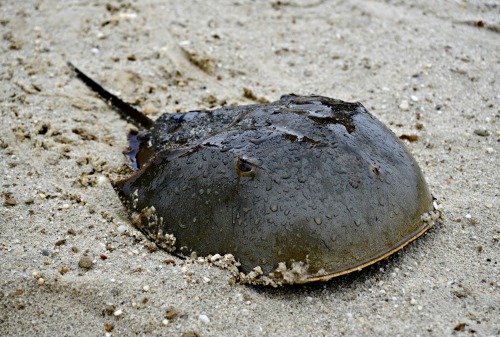May 13, 2016
By Guest Blogger Steve Jasiecki of Sustainable Downbeach
We see them washing up on the beach all the time, these prehistoric looking creatures that seem to come from a primordial era. Horseshoe crabs have changed very little in the 450 million years of their existence. However, their presence plays a very important role in the world’s ecological system and a vital role in medical research.

Horseshoe crabs are not crabs; they are more closely related to spiders and scorpions. Although their appearance seems menacing, they are not dangerous at all. Their tail may look like a weapon, but it is used for navigation and righting itself in the event it gets turned over. Their legs look like pinchers but they are only used for walking, and their mouth has no jaw, so it cannot bite. The only harm they can do is if you back into the spines on the back of their shell, but that would be accidental.
The Delaware Bay is home to the largest horseshoe crab spawning area in the world. Each spring thousands of crabs come to the back bays to lay their eggs at high tide. They can lay up to 20,000 eggs at a time; however, the majority of them are eaten by birds. Very few eggs that do hatch get to make it through their first year of life, becoming food for fish and other creatures.
The eggs provide a high protein source of nutrition for far-ranging migratory birds, such as the Red Knot, which time their migratory flight from South America to arrive when the spawning begins. The high-protein eggs are essential for the Red Knot’s survival. When the birds arrive, they gorge themselves on the eggs and more than double their weight to continue their flight to their breeding ground in the Artic.
The blood of the horseshoe crab has very unique qualities that are beneficial to the biomedical industry. Evolution has developed a blood clotting mechanism that has insured their survival in a highly bacterial environment. Their blue blood is copper based and contains a substance called Limulus Amoebocyte lysate. This substance coagulates in the presence of bacteria toxins. The medical industry uses this substance to determine the sterility of intervenes medicines. Today every new drug that leaves the pharmaceutical company is first tested for purity with Limulus Amoebocyte lysate.
Horseshoe crabs have survived five major extinction periods, but today they are in trouble. From the 1850s to the 1960s, millions of horseshoe crabs have been harvested to make fertilizers. Up until the 1990s fisherman took an average of 800,000 crabs a year to use as bait for eels and conch, a popular food in European and Asian markets. With no regulation, a high demand for horseshoe crabs, and the loss of habitat, their population began to crash.
To ensure their survival, Delaware, New Jersey and Maryland enacted laws to protect them. The harvesting or poaching of horseshoe crabs is now prohibited. Possession of a horseshoe crab is also prohibited except with a scientific collection or educational permit. Getting caught with a horseshoe crab can cost you a very heavy fine.
To further enhance the horseshoe crabs survival, a program called “Return the Favor” was launched. It’s a multi-partner program where sanctioned volunteers are permitted to go to closed beaches and rescue horseshoe crabs that have been overturned or impinged in structures during spawning season so they can make it back to the water. During the 2015 season, over 30,000 horseshoe crabs have been rescued with the help of these volunteers. If you would like more information on the “Return the Favor” or to volunteer see www.returnthefavornj.org
Sustainable Downbeach is working toward creating a healthier, friendlier community with an eye on protecting the environment. For information or to get involved see Sustainable Downbeach on Facebook.
_________________________
The views, opinions and positions expressed are those of the author alone and do not represent those of The Atlantic County Utilities Authority.